Table of Contents
** Minutes
1. What does a high-growth brand look like?
2. What does a highly seasonal brand look like?
3. What does a high-growth brand with unplanned success look like?
4. What does a steady growth brand look like?
Greater demand. Packing boxes nonstop. Too little inventory. Too much inventory. Too much of the wrong inventory. Not enough capital. Slow manufacturing. Stockouts. Backorders. Delayed shipments. Angry customers. Demand plateaus.
Coffee coffee coffee.
Repeat.
Sound familiar? Preparing for growth is never easy.
Here at ShipBob, we work with all kinds of ecommerce brands within different industries, verticals, and growth stages. Across these diverse companies, one thing remains the same: As you plan for what success looks like for your brand, you’ll need to think through how you will handle a changing sales volume across the entire ecommerce supply chain, from inventory management to fulfilment and delivery speed.
Below we look at a few examples of ShipBob customers that have had very different ecommerce growth trajectories, including a brand that has experienced explosive growth, a highly seasonal brand, a brand that’s had unplanned growth, and a gradually growing non-seasonal brand.
Note: The data below is anonymized to protect the confidentiality of the customers and only represents each brand’s sales volume while having ShipBob as their third-party logistics (3PL) partner.
1. What does a high-growth brand look like?
Some brands experience incredible growth or reach an inflection point that results in their product taking off like never before. This spike can come from any combination of events or publicity that can take a brand to the masses, including:
- A television appearance such as Shark Tank or Good Morning America
- Being named to an exclusive list like TIME Magazine’s Best Inventions or awarded Toy of the Year
- A celebrity endorsement or promotion
- Introduction of new sales channels such as being stocked by a mainstream retailer
While this type of exposure and increase in sales may sound like the best possible scenario to some, managing demand and explosive growth is extremely challenging.
From having enough inventory on hand and keeping customers happy to working with new partners and growing your team, there is no shortage of tasks to complete while likely working nonstop and navigating uncharted territory.
Below is the order volume of a ShipBob customer that did just that. Over the course of one year, you can see where the brand took off in addition to their peak and where their volume tabled off. This brand went from only a hundred or so orders a month to suddenly needing to fulfil tens of thousands of orders a month.
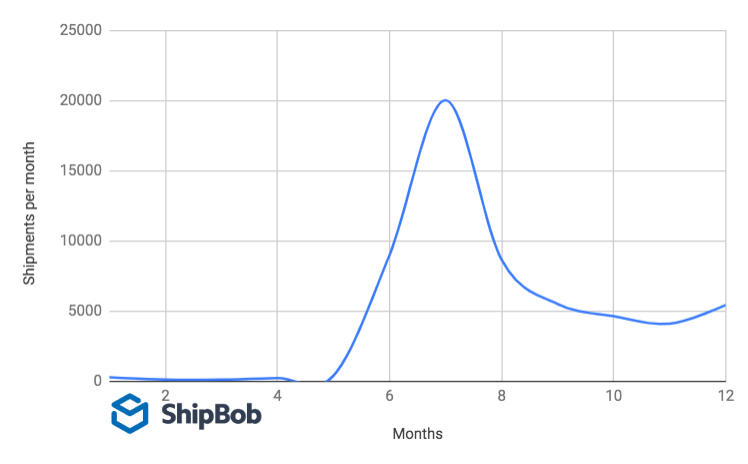
The brand above scaled from having a high of 400 orders in one month to 20,000+ within just two months.
Why would a high-growth brand work with a 3PL?
With breakout success comes new growing pains and challenges from scaling so quickly.
When a brand experiences incredible growth in a short amount of time, it’s daunting to prepare for and know exactly what to expect, especially if you haven’t previously managed a complex ecommerce operation.
Some ecommerce companies invest in the logistics infrastructure themselves, which requires a lot of capital and resources:
- Purchasing land or leasing warehouses that you won’t outgrow right away (and hopefully grow into in time)
- Getting shelving units, pallet racks, conveyors, forklifts, and the licenses or certifications to operate the equipment
- Paying taxes, utilities, employee benefits, workers’ comp, and liability insurance
- Licensing a warehouse management system and other operational tools
- Recruiting and hiring staff labour for both hourly employees and management
- Replenishing boxes, envelopes, tape, dunnage, labels, printers, ink, and other packing materials
With so much to take on, unsurprisingly, many brands turn to third parties that provide the logistical infrastructure and support needed. This means no need to spend capital upfront on a fulfilment centre and equipment, scramble to hire people to pack boxes, or stress about whether you can get orders out on time.
In addition to shipping more volume, it’s highly likely that new success or exposure will require shipping to new places.
3PLs that have multiple locations across different regions allow brands to distribute their inventory, helping them rapidly scale in a feasible and sustainable way. This also helps reduce the average shipping zone that orders are shipped to, reducing shipping costs and time in transit.
2. What does a highly seasonal brand look like?
A seasonal brand is a company whose products primarily serve a specific time period, event, or season, leading to different demand levels depending on the time of year. Of course, many ecommerce companies experience sales that fluctuate month-to-month or see large spikes during peak season when shoppers are buying more from Black Friday through Christmas or other holidays.
Seasonal products have a very different sales pattern from a typical year-round product or brand, whether it’s a summer product that’s best suited for hot weather or a winter product that helps battle the snow and cold. These products become top of mind when they are needed most, leading to predictable busy seasons.
Below is a chart that shows the growth of a ShipBob customer that runs an extremely seasonal business. You’ll notice two major spikes that represent the two heavy seasons they’ve had with ShipBob fulfiling their orders.
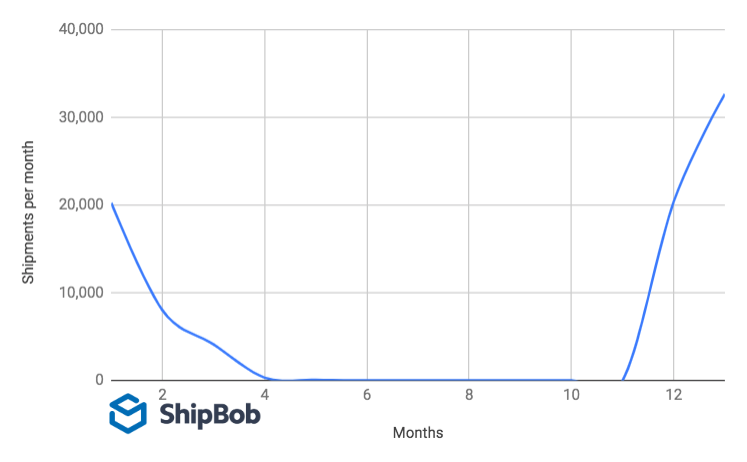
Unlike other seasonal brands that may still have sales year-round (just much less than during the high season), this example has several months of zero orders in between their seasonal peaks. Most recently, this company surpassed 32,000 orders in one month.
Why would a seasonal brand work with a 3PL?
A seasonal business sees high demand at the same time period(s) every year. Year over year, that volume may increase, but their logistics strategy looks very different than a year-round brand. When you don’t have consistent sales and revenue coming in, it can be very expensive and unsustainable to manage logistics in-house over the off months.
During the busy months, fulfiling orders yourself can get extremely chaotic, resulting in delayed shipments. You can hire more temp workers, but they are unfamiliar with your processes. Once staff are up-to-speed, the season wraps up and you have to lay off your new workforce.
3PLs help cyclical businesses ramp up with ease. They already have the facilities to store and fulfil your products, work with thousands of ecommerce merchants, and are experts in logistics, automation, and driving operational efficiencies. You don’t have to worry about tens of thousands of orders getting out on time from one facility, because you can split your inventory across locations and have them shipped more efficiently.
3. What does a high-growth brand with unplanned success look like?
A brand experiencing unplanned growth is likely growing fast, but it’s not always the most predictable growth. Common reasons brands experience these surges include:
- They receive major endorsements organically (e.g., a celebrity is a fan or promoter of the product)
- The influx of demand for their product comes from an unplanned event such as a natural disaster
- There is a sudden shortage in the market
Unlike a seasonal brand, this type of unplanned growth occurs from factors outside of one’s control. Understandably, demand planning becomes very difficult, often leading to backorders and stockouts. These unexpected surges are not too uncommon; They just happen at a different scale and throughout different stages.
The chart below shows a ShipBob customer that has abnormal demand. You’ll notice the extremes month-to-month, sometimes increasing the order volume by 7,000 shipments in under 30 days.

In about a year, the brand above has seen their order volume range from 2,000 orders per month to about 18,000.
What is interesting though is if you zoom out and look at the spikes in growth quarterly versus the monthly view, it looks like very steady growth.
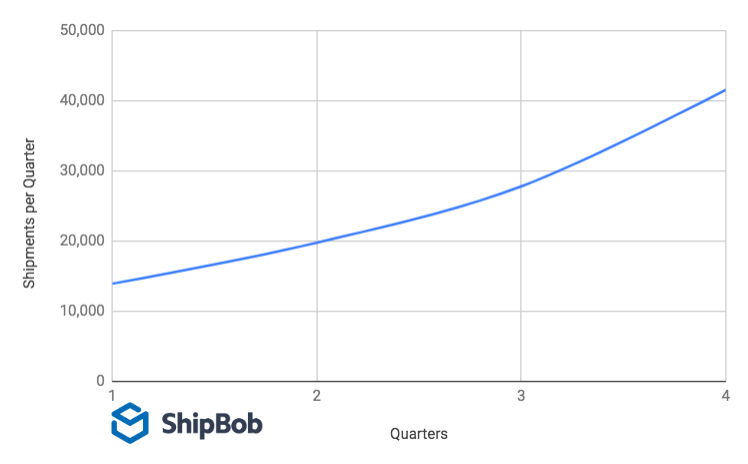
This leads us directly into…
Why would a high-growth brand with unplanned success work with a 3PL?
If a brand is in the position where they suddenly need to ship out thousands of additional orders from what they were expecting, a 3PL makes it easy to accommodate that demand. Some 3PLs have inventory forecasting tools that help merchants track inventory change and velocity over time and set up a proactive reorder point for each SKU to ensure there is always enough product on hand.
Similarly, brands can leverage a 3PL’s multiple locations to spread risk in case of emergencies and have more units available even if they run out of inventory in one facility.
4. What does a steady growth brand look like?
Many brands experience gradual growth, where sales are fairly consistent but volume steadily increases over time. They might not have an overnight success story, but they see smaller spikes during the holidays, when they launch flash sales, or as a result of smaller scale coverage.
There may be a subscription component to the business that brings in recurring revenue, it might be a lifestyle brand that impacts consumers’ day-to-day, or even a company selling products for a niche group of people. This type of growth is calculated, picking up more traction over time.
Brands grow at this pace for many reasons, whether it’s by choice (e.g., they have concerns about maintaining the quality of the product or there is a long or complex production process), or the business is simply not taking off at a rapid speed.
The graph below shows a brand that has achieved steady growth over several years while having ShipBob fulfil their orders. There are natural ebbs and flows but a clear increase in orders over time. The steady growth brand experiences an order volume that shifts about 1,000 orders in either direction month-to-month — an increase that isn’t as drastic as a company that experiences unplanned surges of growth.
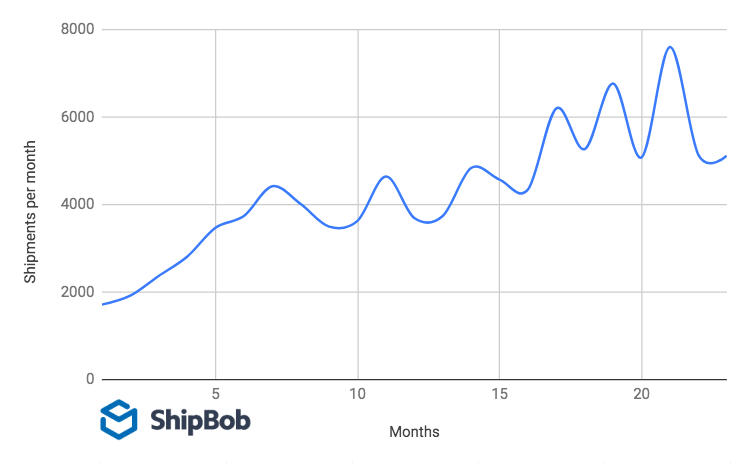
Over two years, the brand above has steadily increased their order volume by about 3,000 orders per year.
Why would a steady growth brand work with a 3PL?
While steady growth is easier to manage logistically than a high-growth, seasonal, or unplanned growth brand for things like purchasing more inventory and forecasting demand, there are still plenty of reasons that brands outsource ecommerce fulfilment to a 3PL.
3PLs can provide bulk shipping discounts, help brands break into new markets with access to affordable international shipping rates, and process orders at scale and more quickly than doing it in-house. By freeing up time that was previously spent self-fulfiling orders, brands are able to focus on new marketing efforts, product development, and other forward-thinking initiatives that help achieve incremental growth instead of having order volume stay flat if they had continued as is.
Many brands reach out to a 3PL when they’ve reached their limit, whether they spend all of their time packing boxes or have run out of space. However, many brands choose to secure a 3PL before hitting a point of chaos.
Comparing 4 DTC brands with the same annual order volume
The chart below shows the same 12-month period for four different brands that average the same monthly shipping volume and have ShipBob fulfil their ecommerce orders. Note: These are not all four of the brands included above.
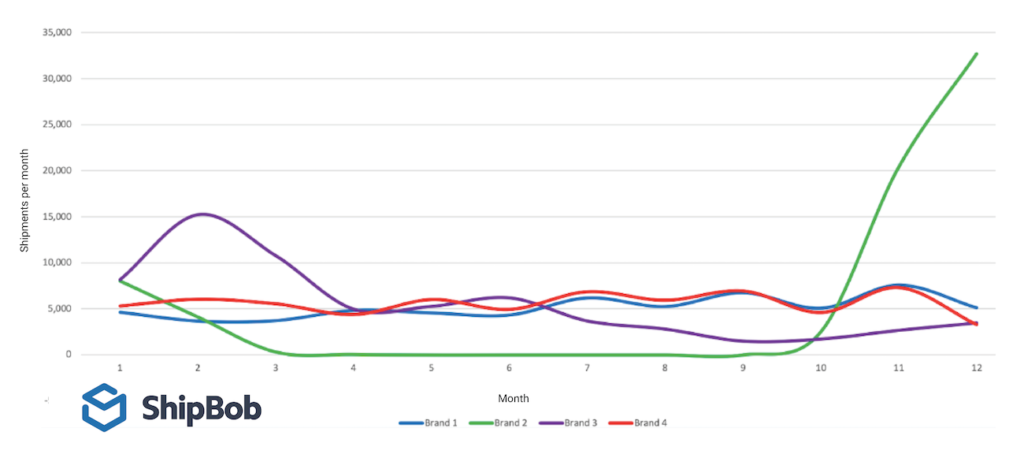
In the full-year snapshot, we see that the four brands shipped the same amount of packages throughout the year but have notable differences month-to-month:
- Brand 1 and Brand 4 follow a very similar path (yet sell very different products)
- Brand 3 peaks at Month 2
- Brand 4 sees virtually zero orders from month 3 to month 9 and experiences a huge spike from Month 10 to Month 12
This shows that four brands that have the same annual order volume can look so different throughout the year.
Conclusion
Preparing and planning for your ecommerce growth is not always easy. Working on digital marketing plans, a major televised event, and any other activities that can affect your growth — expected or not — takes a lot of coordination, infrastructure, and effort.
While the examples above are very different from one another, each brand has experienced growth after partnering with ShipBob to fulfil their ecommerce orders. If you’re interested in learning more about how partnering with a 3PL that has multiple fulfilment centres that are close to your end consumers can drive growth for your ecommerce brand, check out ShipBob.





